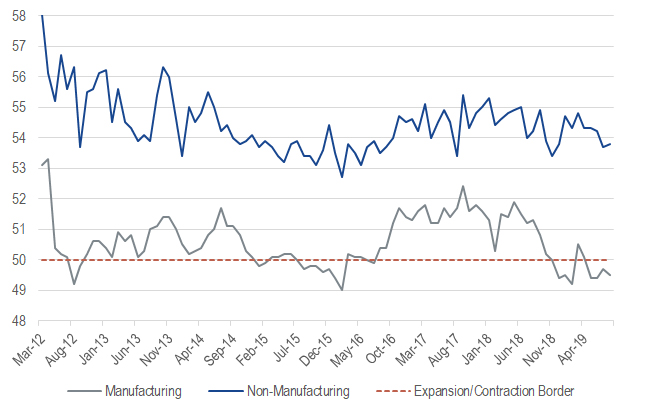By Jan van Eck, VanEck CEO
China has been a major contributor to global growth, and its economic activity tends to have significant repercussions for the global economy. To understand where the Chinese economy is in its growth cycle, the two charts below are perhaps the only charts one needs.
Chinese Economy Health Check: PMIs
Source: Bloomberg. Data as of August 31, 2019. Past performance is no guarantee of future results. Chart is for illustrative purposes only.
Purchasing managers’ indices (PMIs)1 are a better indicator of the health of the Chinese economy than the gross domestic product (GDP) number, which is politicized and is a composite in any case. The manufacturing and non-manufacturing, or service, PMIs have been separated in order to understand the different sectors of the economy. These days, the manufacturing PMI is the number to watch for cyclicality. The latest surveys suggest that this is not going to be an easy ride for the Chinese economy. The weakness in the manufacturing sector looks broad-based, with uncertainty around U.S.-China trade relations being the main drag. One bright spot is that small companies PMIs continue to rebound. Whether the improvement is permanent or not remains to be seen—we are mindful of likely pre-tariff frontloading (especially among exporters)—but we believe the latest figures in the following chart offers some reassurance.
Source: UBS. Data as of September 2, 2019. Past performance is no guarantee of future results. Chart is for illustrative purposes only. Spreads are measured relative to average yield of 1, 3, 5, and 10-year bonds issued by the China Development Bank.
As with any economy, central bank policy is very important in China. In this chart, we can see that interest rates for the private sector fluctuate, whereas the interest rates paid by state-owned enterprises (SOEs) are pretty stable. Therefore, to understand the credit cycle, we point your attention to this private sector, or non-SOE, interest rate. It spiked in 2018, as a result of China’s crackdown on shadow banking2, meaning tougher lending conditions for the private sector. These interest rates began trending down in the winter of 2018 as the “drip stimulus” appeared to take effect. After a recent stint of rising funding costs for private firms, this trend has been reversed, which signals that the preferential policy moves towards the private sector are bringing results. Anecdotal evidence suggests that demand for loans is there, but the gap between potential borrowers and the money persists. Closing this gap would require meaningful structural initiatives. We believe there is scope for cautious optimism here, as authorities continue to show unwavering commitment to the liberalization of interest rates, despite the strain of the trade war.
For more market trends, visit ETF Trends.
For more insights on China, please see VanEck’s outlook for China in 2019.
DEFINITIONS AND DISCLOSURES









